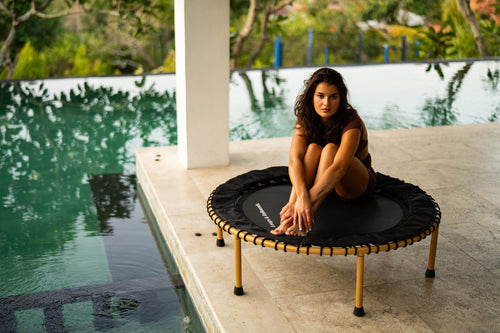Mini-trampolines (or rebounders) offer a fantastic way to get active, stay fit, burn calories, and have fun in your own home.
Rebounding works for people of all ages, from young children who need a break from screens to seniors with limited mobility. But you’re sure to have questions if you’ve never tried rebounding before — and we’ll answer them all for you in this post.

We cover:
- Why mini-trampolines and rebounders offer an effective workout
- The benefits of rebounding for senior citizens
- How to use a rebounder safely
- 3 easy exercises for beginners
Rebounding for beginners: Why they offer an effective workout
One in four adults around the world fails to meet the World Health Organization’s (WHO) guidelines for physical activity: adults should exercise vigorously for 75 minutes or moderately for 150 minutes each week.
Unfortunately, this is easier said than done when you work full-time, have a family to care for, household chores to managing, and a social life to maintain. And gym memberships can be expensive, particularly if you’re on a tight budget.
Fortunately, exercising at home is a much simpler, affordable way to stay fit. And exercising on mini-trampolines and rebounders is more exciting than punishing military-style exercises (push-ups, squats, etc.).
For anyone asking “does rebounding really work for weight loss and fitness?”, using mini-trampolines can help to:
- Boost endurance
- Improve your motor skills, coordination, and balance
- Work and tone muscles in your buttocks, leg, back, and abdominals
- Increase bone density and strength
- Stimulate the lymphatic system to flush toxins and bacteria from the body
Rebounders are smaller than standard trampolines you may have used, with a firmer surface for a better bounce. And they’re easy to carry from one room to another in your home, or out into your backyard if you want to exercise in the fresh air.

Mini-trampolines and rebounders make working out fun for the whole family, too. You can take it in turns, encourage each other to try new moves, and see who can bounce for the longest time. If you’re used to lifting weights for hours each week or running busy public routes, rebounders make a refreshing change.
Just buy one of the many fantastic rebounders on the market, find a quiet space to set it up where you won’t disturb your family or neighbors, and you’re good to go!
Is rebounding safe for senior citizens?
Exercise becomes more difficult with age, but it’s still vital to help your body stay healthy. And mini-trampolines are ideal for seniors who want to be active in the comfort of their own home.
There are multiple key benefits of rebounding for senior citizens, including:
- Rebounding burns calories and gets the heart beating faster without putting as much stress on joints as more vigorous exercises (such as running) do — that’s crucial as bones become weaker with age
- Jumping on mini-trampolines and rebounders helps to improve balance and coordination
- Rebounding can increase blood circulation, encouraging a healthy flow of oxygen around the body and healthy function of major organs
- As rebounding supports bone strength and density, it can help seniors’ skeletal structure stay healthy
- Rebounding is a fantastic alternative to walking, which may be difficult for seniors with mobility problems
How do I use a rebounder safely and with proper form?
Safety and proper form are critical when performing any exercise. As rebounding involves jumping on a small surface, anyone trying it for the first time must take care to follow a few precautions.
Make sure your rebounder is on a flat and stable surface before stepping onto it
This may sound obvious, but if one leg is slightly higher or lower than the others, the entire rebounder may move during use — and you could injure yourself. A balance bar makes stepping on and off safer.

Set your rebounder up away from the nearest wall or fixtures (e.g. shelves):
You should have plenty of space surrounding you in case you have to move your arms during a particular exercise.
Supervise children:
If your children want to try rebounding, always supervise them. The surface is firmer and smaller than standard trampolines, so they maybe a little more vulnerable as beginners.
Monitor your health:
Step off your rebounder if you notice that you feel short of breath or experience pains anywhere in your body.
Senior citizens or anyone with potentially-dangerous health conditions should speak to a doctor before using a rebounder for the first time.
What exercises can I do on a rebounder?
No guide to rebounding for beginners would be complete without a few novice exercises:
Jumping jacks
Jumping jacks are a terrific rebounding exercise: it works as a warm-up exercise or can be made more intense by increasing the speed.
- Alternate between putting your legs together and apart with each bounce
- Swing your arms out at your sides and above your head when you part your legs, before bringing them back down when putting your legs together again
- Start slowly and practice proper form, but only increase your speed when you feel comfortable with the rhythm
Jump squats
Jump squats build the muscles in and around your legs, buttocks, and hips. Performing them on a rebounder makes less impact on the joints.
- Start by bouncing steadily and keep your feet hip-width apart
- Widen your stance with every other bounce you perform, and squat until your hips move past your knees
- Hold for one second and bounce back to your starting stance
Back kick
The back kick can strengthen your thighs, knees, hips, and buttocks.
- Either hold your balance bar or hold your arms up and at your sides
- Alternate lifting one leg behind you while the other is on the rebounder’s surface
- Begin slowly and increase your speed when you feel the rhythm
We hope this guide to mini-trampoline and rebounder's workouts inspires you to start having fun and staying fit at home. Rebounders are widely available and affordable — an ideal workout solution for everyone!
























0 comments